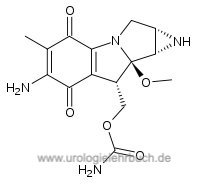You are here: Urology Textbook > Drugs in Urology > Mitomycin C
Mitomycin C: Mechanism, Adverse Effects, Contraindications, and Dosing
Mechanism of Action of Mitomycin C:
Mitomycin C is a cytotoxic antibiotic derived from Streptomyces. After bioreductive enzymatic activation, it produces alkylating DNA damage with predominantly interstrand cross-link formation, which prevents strand separation. The resulting blockade of replication and transcription induces apoptosis.

Urologic Indications for Mitomycin C
- Intravesical chemotherapy for non–muscle-invasive bladder cancer with intermediate risk; see tables on recurrence risk and progression risk.
- Postoperative immediate instillation after transurethral resection of a bladder tumor (TURBT) to prevent recurrence.
- Postoperative immediate instillation after nephroureterectomy for upper tract urothelial carcinoma.
Pharmacokinetics of Mitomycin C
During intravesical administration, systemic absorption is low across an intact urothelial surface. With a clinically relevant perforation, mitomycin C can be absorbed through tissues and the peritoneum.
Adverse Effects of Mitomycin C
Intravesical administration of mitomycin C is generally well tolerated; severe local and systemic adverse effects are very rare.
Frequency 1–10%:
Pollakiuria, dysuria, and hematuria. Allergic skin reactions.
Local Toxicity (< 1%):
Calcification of the bladder wall. Necrotizing cystitis, bladder wall necrosis with urinoma or fistula formation, chemical peritonitis, bladder fibrosis with reduced capacity, ureteral stricture with hydronephrosis. The need for cystectomy as a consequence of mitomycin instillation has been reported.
Contraindications to Intravesical Mitomycin
No intravesical instillation in the presence of bladder perforation, persistent gross hematuria requiring continuous irrigation, or untreated urinary tract infection.
Dosing
To optimize mitomycin activity, alkalinize the urine with sodium bicarbonate, with dosing the evening before and the morning of instillation. To achieve a dwell time of two hours, the patient should drink only small amounts before instillation.
Dosing of Intravesical Chemotherapy with Mitomycin C
Instill 20–40 mg mitomycin c intravesically with single-use catheter once weekly for six weeks. A re-TURBT is usually indicated thereafter. If the intravesical chemotherapy is effective and well tolerated, consider maintenance therapy with monthly instillations of 20–40 mg for up to one year.
Recurrence Prophylaxis After TURBT:
Single intravesical instillation of 40 mg mitomycin C after complete resection of a non–muscle-invasive bladder tumor, provided there is no perforation or significant postoperative bleeding requiring irrigation.
Recurrence Prophylaxis After Nephroureterectomy:
Single intravesical instillation of 40 mg mitomycin C, provided secure bladder closure has been achieved.
| Gemcitabine | Index | Axitinib |
Index: 1–9 A B C D E F G H I J K L M N O P Q R S T U V W X Y Z
References
A. Bohle and P. R. Bock, “Intravesical bacille Calmette-Guerin versus mitomycin C in superficial bladder cancer: formal meta-analysis of comparative studies on tumor progression,” Urology, vol. 63, no. 4, p. 682–6; discussion 686–7, 2004.
DGU; DKG; DKG & Leitlinienprogramm Onkologie S3-Leitlinie (Langfassung): Früherkennung, Diagnose, Therapie und Nachsorge des Harnblasenkarzinoms. https://www.leitlinienprogramm-onkologie.de/leitlinien/harnblasenkarzinom/
T. O’Brien, E. Ray, R. Singh, B. Coker, R. Beard, and B. A. of Urological Surgeons Section of Oncology, “Prevention of bladder tumours after nephroureterectomy for primary upper urinary tract urothelial carcinoma: a prospective, multicentre, randomised clinical trial of a single postoperative intravesical dose of mitomycin C (the ODMIT-C Trial).,” Eur Urol, vol. 60, no. 4, pp. 703–710, 2011.
 Deutsche Version: Nebenwirkungen und Kontraindikationen von Mitomycin C intravesikal
Deutsche Version: Nebenwirkungen und Kontraindikationen von Mitomycin C intravesikal
Urology-Textbook.com – Choose the Ad-Free, Professional Resource
This website is designed for physicians and medical professionals. It presents diseases of the genital organs through detailed text and images. Some content may not be suitable for children or sensitive readers. Many illustrations are available exclusively to Steady members. Are you a physician and interested in supporting this project? Join Steady to unlock full access to all images and enjoy an ad-free experience. Try it free for 7 days—no obligation.
New release: The first edition of the Urology Textbook as an e-book—ideal for offline reading and quick reference. With over 1300 pages and hundreds of illustrations, it’s the perfect companion for residents and medical students. After your 7-day trial has ended, you will receive a download link for your exclusive e-book.